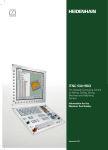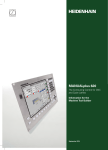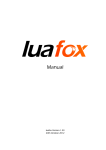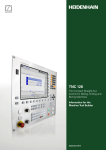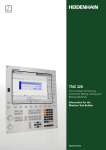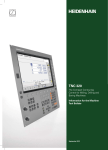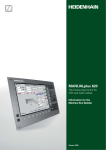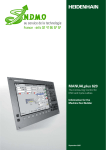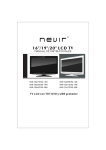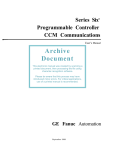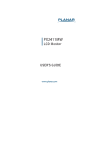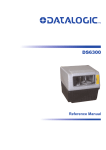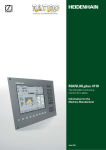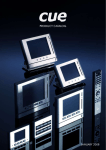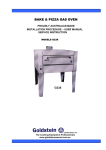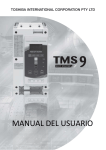Download cnc pilot 620 hsci
Transcript
CNC PILOT 620 HSCI The Contouring Control for CNC Lathes Information for the Machine Tool Builder September 2011 CNC PILOT 620 Contouring Control with Drive System from HEIDENHAIN CNC PILOT 620 • Contouring control for lathes with up to 3 axes (X, Z and Y), controlled spindle and opposing spindle, C1/C2 axis and driven tools • Up to 3 programmable auxiliary axes (U, V, W) for control of steady rest, tailstock and opposing spindle are also supported. • The position of a parallel secondary axis can be shown combined with its principal axis. • HEIDENHAIN inverter systems and motors recommended • Uniformly digital with HSCI interface and EnDat interface • 19-inch TFT flat-panel display • TE 745T operating panel with integrated machine operating panel, electronic handwheel, rapid-traverse and feed-rate override potentiometers, touchpad and ASCII keyboard • Memory medium for NC programs: CompactFlash memory card • smart.Turn programming for turning, boring, drilling and milling • DIN programming for turning, boring, drilling and milling • Cycle programming for turning, boring, drilling and milling • Free ICP contour programming for turning and milling contours • The CNC PILOT supports tool turrets and quick change tool posts (Multifix). The tool carrier can be located in front of or behind the workpiece. • The CNC PILOT also supports vertical lathes. • USB removable media can be connected. BF 760 color flat-panel display with TE 745T keyboard MC 6240 System tests Controls, motors and encoders from HEIDENHAIN are in most cases integrated as components in larger systems. In these cases, comprehensive tests of the complete system are required, irrespective of the specifications of the individual devices. Expendable parts In particular the following parts in controls from HEIDENHAIN are subject to wear: • Buffer battery • Fan Standards Standards (ISO, EN, etc.) apply only where explicitly stated in the catalog. Note Microsoft, Windows, Windows 2000, Windows XP, Windows Vista, Windows 7, Internet Explorer are registered trademarks of Microsoft Corporation. 2 CC 6106 Contents Page 4 Tables with Specifications, Machine Interfacing, User Functions and Accessories Digital Control Design 13 Control Systems 14 Cable Overviews 27 Technical Description 31 Overall Dimensions 50 Documentation 61 Service 62 Subject Index 63 Please refer to the page references in the tables with the specifications. The features and specifications described here apply for the following control and NC software version: CNC PILOT 620 ID 688 945-02 Some of these specifications require particular machine configurations. Please note also that, for some functions, a special PLC program must be created by the manufacturer. This catalog supersedes all previous editions, which thereby become invalid. Subject to change without notice 3 Specifications Specifications CNC PILOT 620 Control systems Page 14 Main computer • MC 6240 main computer • HSCI interface 15 Controller unit CC 61xx or UEC 111 (inverter and system PL integrated) or UEC 112 (inverter and system PL integrated) 17 Visual display unit BF 760 19-inch color flat-panel TFT display 19 Keyboard unit TE 745T (with integrated machine operating panel) 19 PLC inputs/outputs PL 6xxx series or on UEC 11x series 20 Inverter systems * Compact inverters ✔ * Modular inverters ✔ * Axes1) and spindles 32 Axes Up to 6 closed-loop axes X, Z: standard Y, U, V, W: option 32 C1/C2 axis With spindle/opposing spindle motor or separate drive (option) 33 Driven tool Option 33 Synchronized axes ✔ 35 PLC axes ✔ 35 Spindle Closed-loop 33 Shaft speed2) Max. 60 000 min–1 33 Operating-mode switchover ✔ 33 Position-controlled spindle ✔ 33 Oriented spindle stop ✔ Gear shifting ✔ NC program memory 250 MB Input resolution and display step Linear axes X axis: 0.5 μm (diameter: 1 μm) Z axis: 1 μm Y axis: 1 μm U, V, W axis: 1 μm C1/C2 axis 0.001° 1) As ordered On motors with two pole pairs * For further information, refer to the Inverters brochure (ID 622 420-xx) 2) 4 33 Specifications CNC PILOT 620 Page Straight line In 2 axes (max. ± 100 m), optional in 3 principal axes ** Circle In 2 axes (radius max. 999 m), optional additional linear interpolation of the third axis ** C1/C2 axis Interpolation of X and Z linear axes with the C1/C2 axis (option) ** Interpolation Axis feedback control 34 With following error ✔ 34 With feedforward ✔ 34 With jerk limiting ✔ 37 Feed rate Maximum feed rate: 60 000 min–1 · screw pitch [mm] No. of pole pairs in motor 32 at fPWM = 5 000 Hz Constant surface speed ✔ 32 Input mm/min or mm/revolution 32 Cycle times of main computer MC 6240 36 Block processing 3 ms 36 Cycle times of controller unit CC 61xx/UEC 11x 36 Path interpolation 3 ms 36 Fine interpolation 0.2 ms 36 Position controller 0.2 ms 36 Speed controller 0.2 ms 36 Current controller fPWM 3 333 Hz 4 166 Hz 5 000 Hz 6 666 Hz 8 333 Hz 10 000 Hz Permissible temperature range Operation: In electrical cabinet: 5 °C to 40 °C In operating panel: 0 °C to 50 °C Storage: –20 °C to +60 °C TINT 150 μs 120 μs 100 μs 75 μs 60 μs 50 μs 36 ** For further information, refer to the brochure CNC PILOT 620 5 Machine Interfacing Machine interfacing CNC PILOT 620 Error compensation Page 39 Linear axis errors ✔ 39 Nonlinear axis errors ✔ 39 Backlash ✔ 39 Hysteresis, reversal peaks ✔ 39 Thermal expansion ✔ 39 Stick-slip friction ✔ 39 Sliding friction ✔ 39 Integral PLC 43 Program format Statement list 43 Program input via the control ✔ 43 Program input via PC ✔ 43 Symbolic PLC-NC interface ✔ 43 PLC memory 50 MB 43 PLC cycle time 21 ms, adjustable 43 PLC inputs/outputs Max. 8 PL 6xxx (1 PL 62xx or UEC 11x and max. 7 PL 61xx) 20 PLC inputs, 24 V DC Via PL or UEC 11x 20 PLC outputs, 24 V DC Via PL or UEC 11x 20 Analog inputs, ± 10 V Via PL 20 Inputs for PT 100 thermistors Via PL 20 Analog outputs, ± 10 V Via PL 20 PLC functions ✔ 43 PLC soft keys ✔ 43 PLC positioning ✔ 43 PLC basic program ✔ 45 6 Machine Interfacing, Accessories Machine interfacing CNC PILOT 620 Page Encoder inputs UEC 111 UEC 112 CC 6106 CC 6108 CC 6110 38 Position 4 5 6 8 10 38 Incremental 1 VPP 38 Absolute EnDat 38 Rotational speed 4 5 6 8 10 38 Incremental 1 VPP 38 Absolute EnDat 38 Commissioning and diagnostic aids 41 ConfigDesign Software for configuring the machine parameters 41 DriveDiag Software for diagnosis of digital drive systems 41 TNCopt Software for putting digital control loops into service 41 Integrated oscilloscope ✔ 42 Trace function ✔ 42 Logic diagram ✔ 42 API DATA function ✔ 42 Table function ✔ 42 OnLine Monitor (OLM) ✔ 41 Log ✔ 42 TNCscope ✔ 42 Data interfaces 46 Ethernet (100BaseT) ✔ 46 USB 2.0 8 (6 x monitor, 2 x MC) 46 RS-232-C/V.24 Can only be controlled via PLC 46 Protocols 46 Standard data transfer ✔ 46 Blockwise data transfer ✔ 46 LSV2 ✔ 46 Integration of applications 44 High-level language programming Python programming language used in combination with the PLC (option 46) 44 User interface can be custom-designed Inclusion of specific user interfaces from the machine tool builder (option 46) 44 7 Accessories CNC PILOT 620 Page Electronic handwheels One HR 410 (as an alternative to the panel-mounted handwheel) 23 Touch probes • One TS 220, TS 440, TS 444, TS 640 or TS 740 workpiece touch probe • One TT 140 tool touch probe 24 PLC input/output systems With HSCI interface 20 Basic module System PL1) PLB 6204 for 4 I/O modules PLB 6206 for 6 I/O modules PLB 6208 for 8 I/O modules 20 Expansion PL PLB 6104 for 4 I/O modules PLB 6106 for 6 I/O modules PLB 6108 for 8 I/O modules 20 I/O modules PLD-H 16-08-00: 16 digital inputs and 8 digital outputs, 24 V PLD-H 08-16-00: 8 digital inputs and 16 digital outputs, 24 V PLA-H 08-04-04: 8 analog inputs ± 10 V, 4 analog outputs ± 10 V and 4 analog PT 100 inputs 20 USB hub ✔ 46 PLC basic program2) ✔ 45 DataPilot MP/CP 620 programming station Control software for PCs for programming, archiving, and training * PLCdesign2) PLC software development environment 44 KinematicsDesign2) Software for kinematic configuration 40 TNCremo3) Data transfer software 47 TNCremoPlus3) Data transfer software with live-screen function 47 TNCscope2) Software for data recording 42 ConfigDesign2) Software for configuring the machine parameters 41 DriveDiag2) Software for diagnosis of digital drive systems 41 IOconfig2) Software for configuring PLC I/O and PROFIBUS-DP components 20 TNCopt2) Software for putting digital control loops into service 41 TeleService2) Software for remote diagnostics, monitoring, and operation 42 RemoTools SDK2) Function library for developing customized applications for communication with HEIDENHAIN controls 47 Software * For further information, refer to the CNC PILOT 620 brochure 1) Integrated in UEC 11x, otherwise necessary once in each HSCI control system 2) Available to registered customers for downloading from the Internet 3) Available to all customers (without registration) for downloading from the Internet 8 Configuration Option User functions Standard User Functions • 0-6 55+0-6 70+0-6 94+0-6 132+0-6 • Operating modes Manual operation • • 11 Teach-in mode 8 Program run Programming Cycle programming Manual slide movement through axis-direction keys, intermediate switch or electronic handwheels Graphic support for entering and running cycles without saving the machining steps in alternation with manual machine operation Thread reworking (thread repair in a second workpiece setup) Sequential linking of fixed cycles, where each cycle is run immediately after input, or is graphically simulated and subsequently saved 9 8 All are possible in single-block and full-sequence modes DIN PLUS programs smart.Turn programs Cycle programs 17 17 17 Workpiece datum setting Definition of tool-change position Definition of protection zone Definition of machine dimensions Manual programs Tool measurement by touching the workpiece Tool measurement with a TT tool touch probe Tool measurement with an optical gauge Workpiece measurement with a TS workpiece touch probe • Setup functions Basic version: X and Z axis, spindle Driven tool and auxiliary axes (U, V, W) C axis and driven tool Y axis Parallel axes (U, V, W) Opposing spindle Digital current and speed control • • • • • • 8 8 8 8 8 8 8 8 8+55 8+55 8+55 8+55 8+55 8+55 8 8 8 8+9 Turning cycles for simple and complex contours, as well as contours defined with ICP Contour-parallel turning cycles Recessing cycles for simple or complex contours, as well as contours defined with ICP Repetitions with recessing cycles Recess turning cycles for simple and complex contours, as well as contours defined with ICP Undercut and parting cycles Engraving cycles Threading cycles for single or multi-start longitudinal, taper or API threads, threads with variable pitch Cycles for axial and radial drilling, pecking and tapping operations with the C axis Thread milling with the C axis Axial and radial milling cycles for slots, figures, single surfaces and polygons as well as for complex contours defined with ICP for machining with the C axis Helical slot milling with a (multi-start) C axis Deburring of ICP contours Linear and circular patterns for drilling, boring and milling operations with the C axis Context-sensitive help graphics Transfer of cutting values from technology database Use of DIN macros in cycle programs Conversion of cycle programs to smart.Turn programs 9 Option Interactive contour programming (ICP) Contour definition with linear and circular contour elements Immediate display of entered contour elements Calculation of missing coordinates, intersections, etc. Graphic display of all solutions for selection by the user if more than one solution is possible Chamfers, rounding arcs and undercuts available as form elements Input of form elements immediately during contour creation or by superimposition later Changes to existing contours can be programmed Machining attributes available for individual contour elements C-axis machining on face and lateral surface: Description of individual holes and hole patterns (only in smart.Turn) Description of figures and figure patterns for milling (only in smart.Turn) Creation of freely definable milling contours 9+70 Y-axis machining on the XY and ZY planes (only in smart.Turn): Description of individual holes and hole patterns Description of figures and figure patterns for milling Creation of freely definable milling contours 8/9+55+ Programming of the rear face for full-surface machining with the C and Y axes 70+132 8/9+42 DXF import: Import of contours for lathe and milling operations smart.Turn programming Basis is the unit, which is the complete description of a machining block (geometry, technology and cycle data) Dialog boxes divided into overview and detail forms 9 Fast navigation between the fillable forms and input groups via the “smart” keys 9 Context-sensitive help graphics 9 Start unit with global settings 9 Transfer of global values from the start unit 9 Transfer of cutting values from technology database 9 Units for all turning and recessing operations for simple contours and ICP contours 9 9+55/70 Units for boring, drilling and milling operations with the C and Y axis for simple holes, milling contours and drilling and milling patterns as well as those programmed with ICP 9+55 Special units for subroutines, section repeats and activating/deactivating the C axis Verification graphics for blank and finished part and for C and Y axis contours 9 Turret assignment and other setup information in the smart.Turn program 9 Parallel programming 9 Parallel simulation 9 DIN PLUS programming 10 Standard User functions 8/9 8/9 8/9 8/9 8/9 8/9 8/9 8/9 8/9+55 9 • • • • Programming in DIN 66025 format Extended command format (IF ... THEN ... ELSE ...) Simple geometry programming (calculation of missing data) Powerful fixed cycles for area clearance, recessing, recess turning and thread machining Powerful fixed cycles for boring, drilling and milling with the C axis 55 Powerful fixed cycles for boring, drilling and milling with the Y axis 70 • Subroutines Technology functions for full-surface machining: • – Moving to a fixed stop • – Parting control – Spindle synchronization 131/132 – Converting and mirroring 132 • – Mechatronic tailstock • Programming with variables Contour description with ICP 8/9 • Program verification graphics for workpiece blank and finished part • Turret assignment and other setup information in the DIN PLUS program Conversion of smart.Turn units into DIN PLUS command sequences 9 • Parallel programming • Parallel simulation Test run graphics • • • • • • • • • Machining time analysis • • • Tool database • • • • • • • • • Technology database Conversational languages Option Standard User functions Graphic simulation of the cycle process, or of the cycle, smart.Turn or DIN PLUS program Display of the tool paths as wire-frame or cutting-path graphics, special identification of the rapid-traverse paths Machining simulation (2-D material-removal graphic) Side or face view, or 2-D view of cylindrical surface for verification of C-axis machining Display of programmed contours View of face and YZ plane for verification of Y-axis machining Three-dimensional display of the workpiece blank and finished part Simulation of mirrored contours for rear-face machining Shifting and magnifying functions Calculation of machining time and idle machine time Consideration of switching commands triggered by the CNC Representation of time per individual cycle or per tool change For 250 tools 10 For 999 tools Tool description can be entered for every tool Automatic checking of tool-tip position with respect to the contour Compensation of tool-tip position in the X/Y/Z plane High-precision correction via handwheel, capturing compensation values in the tool table Automatic tool-tip and cutter radius compensation Tool monitoring for lifetime of the insert (tool tip) or the number of workpieces produced 10 Tool monitoring with automatic tool change after tool insert wear Management of multipoint tools (multiple inserts or reference points) Support of quick-change systems 8/9 Access to cutting data after definition of workpiece material, cutting material and machining mode. The CNC PILOT 620 distinguishes between 16 machining modes. Each workpiece-material/tool-material combination includes the cutting speed, the main and secondary feed rates, and the infeed for 16 machining modes. 8/9 Automatic determination of the machining modes from the cycle or the machining unit 8/9 Cutting data is entered in the cycle or in the unit as default values 8/9 9 workpiece-material/tool-material combinations (144 entries) 10 62 workpiece-material/tool-material combinations (992 entries) • Chinese (simplified), Chinese (traditional), Czech, Danish, Dutch, English, Finnish, French, German, Hungarian, Italian, Polish, Portuguese, Russian, Spanish, Swedish 41 For more conversational languages, see Option 11 Options Option number Option NC software 688 945- ID Comment 0 1 2 3 4 5 6 Additional axis 01 01 01 01 02 02 02 354 540-01 353 904-01 353 905-01 367 867-01 367 868-01 370 291-01 307 292-01 Additional control loops 1 to 7 8 Software option 1 Teach-in 01 632 226-01 Cycle programming • Contour description with ICP • Cycle programming • Technology database with 9 workpiece-material/tool-material combinations 9 Software option 2 smart.Turn 01 632 227-01 smart.Turn • Contour description with ICP • Programming with smart.Turn • Technology database with 9 workpiece-material/tool-material combinations 10 Software option 3 Tools and technology 01 632 228-01 Tools and technology • Tool database expanded to 999 entries • Technology database expanded to 62 workpiece-material/tool-material combinations • Tool life monitoring with exchange tools 11 Software option 4 Thread cutting 01 632 229-01 Threads • Thread recutting • Handwheel superimposition during thread cutting 17 Touch probe functions 01 632 230-01 Tool and workpiece measurement • Determining tool-setting dimensions with a tool touch probe • Determining tool-setting dimensions with an optical gauge • Automatic workpiece measurement with a workpiece touch probe 18 HEIDENHAIN DNC 02 526 451-01 Communication with external PC applications over COM component 24 Gantry axes 02 634 621-01 Gantry axes combination in master-slave torque control 41 Additional language 01 530 184-01 530 184-02 530 184-03 530 184-04 530 184-06 530 184-07 530 184-08 530 184-09 530 184-10 Slovenian Slovak Latvian Norwegian Korean Estonian Turkish Romanian Lithuanian 42 DXF import 01 632 231-01 DXF import Import of DXF contours 46 Python OEM process 02 579 650-01 Python application on the CNC PILOT 55 C-axis machining 01 633 944-01 C-axis machining 70 Y-axis machining 01 661 881-01 Y-axis machining 94 Parallel axes 02 679 676-01 Support of parallel axes (U, V, W) Combined display of reference axis and minor axis 131 Spindle synchronism 02 806 270-01 Synchronization (of two or more spindles) 132 Opposing spindle 02 806 275-01 Opposing spindle (spindle synchronism, rear-face machining) 12 Digital Control Design Uniformly digital In the uniformly digital control design from HEIDENHAIN, all components are connected to each other via purely digital interfaces: The control components are connected via HSCI (HEIDENHAIN Serial Controller Interface), the new real-time protocol from HEIDENHAIN for Fast Ethernet, and the encoders are connected via EnDat 2.2, the bidirectional interface from HEIDENHAIN. This achieves a high degree of availability for the entire system. It can be diagnosed and is immune to noise—from the main computer to the encoder. These outstanding properties of the uniform digital design from HEIDENHAIN guarantee not only very high accuracy and surface quality, but rapid traverse speeds as well. Please refer to the Uniformly Digital Technical Information sheet for more detailed information. HSCI HSCI, the HEIDENHAIN Serial Controller Interface, connects the main computer, controller(s) and other control components. HSCI is based on 100BaseT Ethernet hardware. A special interface component developed by HEIDENHAIN has shortened cycle times for data transfer. Main advantages of the control design with HSCI: • Hardware platform for flexible and scalable control system (e.g. local axis systems) • High noise immunity due to digital communication between components • Greater cable lengths in the entire system (HSCI up to 70 m) • More PLC inputs/outputs • Simpler wiring (initial operation, configuration) • Inverters remain connected via proven PWM interface CC or UEC controller units, up to eight PL 6xxx input/output modules, and an MB machine operating panel can be connected to the serial HSCI bus of the MC main computer. The HR handwheel is connected directly to the machine operating panel. The combination of visual display unit and main computer housed in the operating panel is especially advantageous. All that is required is the power supply and an HSCI line to the controller in the electrical cabinet. HSCI components Maximum number MC HSCI master 1 in the system CC, UEC HSCI slave 4 drive-control motherboards (distributed to CC, UEC as desired) MB 6xx, PLB 6001 HSCI slave 2 in the system PLB 62xx HSCI slave 1 in the system (not with UEC 11x) PLB 61xx HSCI slave 7 in the system HR handwheel On MB 6xx or PLB 6001 1 in the system PLD-H-xx-xx In PLB 6xxx 64 in the system Total of up to 9 components 13 CNC PILOT 620 HSCI Control System Overview The CNC PILOT 620 contouring control consists of the following components: CNC PILOT 620 Model Page Main computer MC 6240 15 Memory card CFR 16 NC software license SIK component 16 Power supply unit PSL 130 (as required) Controller unit Control loops UEC 1111) Max. 4 UEC 112 Max. 5 PLC inputs/outputs System PL Expansion PL PL 6xxx series Integrated Max. 7 PLB 610x PL 6xxx PL 6xxx series series 1 PLB 620x Integrated Max. 7 PLB 610x Max. 7 PLB 610x Visual display unit BF 760 19 Keyboard unit TE 745T 19 Connecting cables Accessories 14 1) CC 6106 Max. 6 21 CC 6108 Max. 8 CC 6110 Max. 10 17 20 27 Electronic handwheels HR 410 23 Touch probes TS 220 or TS 440 or TS 444 or TS 640 or TS 740 24 TT 140 1) PSL 130 Inverter and system PL integrated Main Computer Main computer The MC 6240 main computer includes: • Processor (Pentium M 1.8 GHz) • 1 GB RAM memory • HSCI interface to the controller unit and to other control components • HDL interface to the BF 760 screen • USB interface to the TE 745T operating panel • Further interfaces, such as Ethernet, USB, RS-232-C/V.24 To be ordered separately, and installed in the main computer by the OEM: • CFR memory card with the NC software • SIK component (System Identification Key) for enabling control loops and options The following HSCI components are necessary for operation of the CNC PILOT 620: • MC main computer • Controller unit • PL 62xx PLC input/output unit (system PL; integrated in UEC 11x) • TE 745T keyboard unit with integrated machine operating panel or PLB 6001 HSCI adapter for connection of an OEM machine operating panel MC 6240 Weight 3.6 kg Power loss 40 W ID 732 576-01 Power supply If a CC 61xx controller unit is used, the PSL 130 supplies 24 V DC to the main computer and other HSCI components. If a UEC controller unit is used, a PSL 130 is only required if the current consumption is greater than 3.5 A. For the entire HSCI system, the 24 V DC NC supply voltage for the control components is required to be safely separated voltage (PELV). It must not be connected to the 24 V DC supply voltage for PLC components (e.g. holding brakes). Options The capabilities of the CNC PILOT 620 can also be adapted retroactively with options to meet new requirements. These options are described on page 12. They are enabled by entering keywords based on the SIK number, and are saved in the SIK component. Please indicate your SIK number when ordering new options. 15 Main Computer—CFR Memory Card, SIK Component CFR CompactFlash The CFR (= CompactFlashRemovable) CompactFlash memory card holds the NC software for the CNC PILOT 620. It is also the memory medium for NC programs (up to 250 MB) and the PLC program (up to 50 MB). CNC PILOT 620 SIK component ID 728 829-51 The SIK component holds the NC software license for enabling control loops and software options. It gives the main computer an unambiguous ID code—the SIK number. The SIK component is ordered and shipped separately. It must be inserted in a special slot in the MC main computer. The SIK component with the NC software license is available in various versions, depending on the enabled control loops. Additional control loops can be enabled later by entering a keyword. HEIDENHAIN provides the keyword, which is based on the SIK number. When ordering, please indicate the SIK number of your control. When the keywords are entered in the control, they are saved in the SIK component. This enables and activates the options. Should service become necessary, the SIK component must be inserted in the replacement control to enable all required options. Master keyword (general key) There is a master keyword (general key) for putting the CNC PILOT 620 into service that will unlock all options for a duration of 90 days. After this period, only those options with the correct keywords will be active. The general key is activated using a soft key. NC software license and enabling of control loops There are always three control loops enabled in the basic version. The controller unit must designed for the corresponding number of activated control loops. Maximum numbers: • UEC 111: 4 control loops • UEC 112: 5 control loops • CC 6106: 6 control loops • CC 6108: 8 control loops • CC 6110: 10 control loops NC software license SIK with software license and enabling for ID 3 control loops and option smart.Turn (option 9) 732 577-51 Additional axes 16 Option number ID 1st additional control loop 0 354 540-01 2nd additional control loop 1 353 904-01 3rd additional control loop 2 353 905-01 4th additional control loop 3 367 867-01 5th additional control loop 4 367 868-01 6th additional control loop 5 370 291-01 7th additional control loop 6 370 292-01 SIK component Controller Unit Controller unit Due to the very short cycle times of the position, velocity and current controllers, the controller units from HEIDENHAIN are equally suited for conventional drives, for direct drives (linear motors, torque motors) and for HSC spindles. They permit a high loop gain and short reaction times to changing machining forces, and so make the high contour accuracy and surface quality of the workpiece possible. Number of control loops The number of enabled control loops depends on the SIK (see Main Computer ), or on additionally enabled control loops, which can also be ordered as needed at a later date. Versions Controller units and main computers operate in any desired combination. HEIDENHAIN offers the following versions: • Modular CC 61xx controller unit with PWM interface to the inverters • Compact UEC 11x controller units with integrated inverter CC 61xx The CC 61xx controller unit features: • Position controller • Speed controller • Current controller • HSCI interfaces • PWM interfaces to the UM 1xx, UR 2xx, and UE 2xx power modules • Interfaces to the speed encoders • Interfaces to the position encoders • Interfaces for the power supply (supply via UVR 1xx D, UE 2xx D or UR 2xx) • SPI interfaces for expansion modules (e.g. CMA-H) CC 6106 CC 6108 CC 6110 Digital control loops Max. 6 Max. 8 Max. 10 Speed inputs 6 x 1 VPP or EnDat 2.2 8 x 1 VPP or EnDat 2.2 10 x 1 VPP or EnDat 2.2 Position inputs 6 x 1 VPP or EnDat 2.2 8 x 1 VPP or EnDat 2.2 10 x 1 VPP or EnDat 2.2 PWM outputs 6 8 10 Weight 4.1 kg 4.7 kg 4.8 kg ID 662 636-xx 662 637-01 662 638-01 CC 6106 CC 6108 17 UEC 11x The compact UEC 11x controller units not only include the controller with PLC inputs and outputs, but also an inverter with integrated braking resistor. They offer a complete solution for machines with a limited number of axes and low power demands. Controller unit • Position controller, speed controller, current controller • HSCI interface • Interfaces to the speed and position encoders Inverters • • • • System PL • Interfaces for one workpiece touch probe and one tool touch probe • PLC with 38 inputs and 23 outputs (of which 7 outputs can be switched off) freely available (expandable via PL 61xx) • Configuration with IOconfig PC software Power electronics Connections for axis motors and spindle motor Braking resistor Connections for motor holding brakes UEC 111 UEC 112 Controller unit 4 digital control loops 5 digital control loops Speed inputs 4 x 1 VPP or EnDat 2.2 5 x 1 VPP or EnDat 2.2 Position inputs 4 x 1 VPP or EnDat 2.2 5 x 1 VPP or EnDat 2.2 Inverters 2 axes 1 axis Spindle 3 axes 1 axis Spindle 3 333 Hz 6.0/12.0 A 9.0/18.0 A 24.0/36.0 A 6.0/12.0 A 9.0/18.0 A 24.0/36.0 A 4 000 Hz 5.5/11.0 A 8.3/16.5 A 22.0/33.0 A 5.5/11.0 A 8.3/16.5 A 22.0/33.0 A 5 000 Hz 5.0/10.0 A 7.5/15.0 A 20.0/30.0 A 5.0/10.0 A 7.5/15.0 A 20.0/30.0 A 6 666 Hz 4.2/8.4 A 6.3/12.6 A 16.8/25.2 A 4.2/8.4 A 6.3/12.6 A 16.8/25.2 A 8 000 Hz 3.6/7.3 A 5.5/11.0 A 14.6/21.9 A 3.6/7.3 A 5.5/11.0 A 14.6/21.9 A 10 000 Hz 3.0/6.0 A 3.0/6.0 A 12.2/18.3 A 3.0/6.0 A 3.0/6.0 A 12.2/18.3 A Rated current IN/ Max. current Imax1) at PWM frequency Power supply 3AC 400 V to 480 V (± 10 %); 50 Hz to 60 Hz Rated power of DC link 14 kW 14 kW Peak power2) of DC link 18 kW / 25 kW 18 kW / 25 kW Power loss at IN (approx.) 450 W 450 W DC-link voltage 565 V DC 565 V DC Integral braking resistance 2.1 kW / 27 kW 2.1 kW / 27 kW Power pack for HSCI components 24 V/3.5 A 24 V/3.5 A Module width 175 mm 175 mm Weight (approx.) 20 kg 20 kg ID 625 777-xx 625 779-xx 1) 2) Axes: Spindle: 1st value: 2nd value: 18 0.2 s 10 s 40 % 4s Cyclic duration factor for duty cycle time of 10 s with 70 % rated current preload Cyclic duration factor for duty cycle time of 60 s with 70 % rated current preload Cyclic duration factor for duty cycle time of 10 minutes (S6-40 %) Cyclic duration factor for duty cycle time of 20 s 19‘‘ Screen and Keyboard BF 760 color flat-panel display • ID 732 589-01 • Weight 8.4 kg • • • • • • • • Keyboard unit TE 745T Power supply 24 V DC/approx. 65 W 19-inch; 1 280x1 024 pixels HDL interface to the MC 6240 Horizontal soft-key row (NC) Vertical soft-key row at left and right (PLC) Keys for shifting the horizontal or vertical soft-key row Screen layout Operating-mode switchover • ID 801 306-01 • Weight approx. 4.5 kg • • • • • • • • • • • • • Suitable for BF 760 ASCII keyboard Operating mode keys Numeric keypad Editing keys smart.Turn keys Rapid-traverse and feed-rate override potentiometers Electronic handwheel Two bore holes (22 mm) for additional RAFI button or keylock switch (shipped blocked with a cover) Spindle-speed and feed-rate override potentiometers USB interface with cover cap in front USB interface to the MC 6xxx Touchpad BF 760 TE 745 T Integrated machine operating panel with: • 36 exchangeable snap-on keys, 19 of them are not labeled and freely definable via the PLC • Operation keys Assigned according to the PLC basic program: Control voltage on; Emergency stop; NC start; NC stop; six manual direction keys (+X, –X, +Z, –Z, +Y, –Y), rapid traverse key, spindle on (M3/M4 direction), spindle stop, spindle jog (M3/M4 direction), spindle change key, increase/decrease spindle speed by 5 %, set spindle speed to programmed value, feed stop • 7 free PLC inputs and 5 free PLC outputs • Power supply 24 V DC (NC)/approx. 4 W • HSCI interface 19 PL 6xxx PLC Input/Output Systems with HSCI The PLC inputs and outputs are available via external modular PL 6xxx PLC input/output systems. These consist of a basic module and one or more I/O modules, and are connected to the MC main computer via the HSCI interface. The PL 6xxx units are configured with the IOconfig software for PCs. Basic modules There are basic modules with HSCI interface available for four, six or eight I/O modules. They are mounted on standard NS 35 rails (DIN 46 227 or EN 50 022) Supply voltage 24 V DC Power consumption Approx. 48 W at 24 V DC NC Approx. 21 W at 24 V DC PLC Weight 0.36 kg (bare) System PL • Necessary once for each control system (except with UEC) • Includes connections for TS and TT touch probes, as well as TL • Safety-relevant inputs/outputs PLB 6204 PLB 6206 PLB 6208 For 4 I/O modules For 6 I/O modules For 8 I/O modules Expansion PL For connection to the system PL to increase the number of PLC inputs/outputs PLB 6104 PLB 6106 PLB 6108 For 4 I/O modules For 6 I/O modules For 8 I/O modules ID 591 832-03 ID 630 054-03 ID 630 055-03 ID 591 832-03 ID 630 058-03 ID 630 059-03 Up to eight PL 6xxx units can be connected to the control (one PLB 62xx or UEC 11x and up to seven PLB 61xx). The maximum cable length results from the maximum permissible length of the HSCI chain of 70 m. I/O modules For HSCI: There are I/O modules with digital and analog inputs and outputs. For partially occupied basic modules, the unused slots must be occupied by an empty housing. PLD-H 16-08-00 PLD-H 08-16-00 I/O module with 16 digital inputs and 8 digital outputs I/O module with 8 digital inputs and 16 digital outputs Total current Power output Weight PLD-H 16-08-00 PLD-H 08-16-00 PLA-H 08-04-04 Analog module for PL 6xxx with • 8 analog inputs, ± 10 V DC • 4 analog outputs, ± 10 V DC • 4 analog inputs for PT 100 thermistors Weight ID Empty housing 20 0.2 kg 675 572-01 For unused slots ID IOconfig (accessory) Outputs 0 to 7: i 2 A per output (i8 A simultaneously) Max. 200 W 0.2 kg ID 594 243-02 ID 650 891-02 383 022-11 PC software for configuring HSCI and PROFIBUS components PLB 62xx xx x Power Supply for HSCI Components To power the HSCI components, HEIDENHAIN offers the PSL 130 power supply unit. The PSL 130 is supplied either with line and DC-link voltage or only with line voltage. The PSL 130 provides the safely separated +24 V DC NC power supply required for the HSCI components by EN 61 800-5-1. The NC supply voltage and the PLC supply voltage are separated from each other by basic insulation. Supply voltage Line voltage: 400 V AC ± 10% 50 Hz and DC-link voltage: 400 V DC to 750 V DC Power consumption: Max. 1000 W Outputs NC: PLC: Total: PSL 130 24 V DC/i 20 A (double insulation from line power) 5 V DC/i 16 A (only with PSL 135) electrically connected with 24 V NC 24 V DC/i 20 A (basic insulation from line power) Max. 32 A/750 W The PSL 130 serves as a 24 V DC power supply unit for supplying the HSCI components. If a UEC controller unit is used, then the PSL 130 is not necessary if the total current consumption of the connected HSCI components does not exceed 3.5 A. HSCI component PSL 130 Current consumption 24 V DC NC Main computer MC 624x 1.7 A Operating panel TE 745T 0.2 A (without handwheel) Machine operating panel PLB 6001 0.2 A (without handwheel) PLC inputs/outputs PLB 62xx PLB 61xx PLD PLA 0.3 A (without touch probe) 0.2 A 0.05 A 0.1 A Screen BF 760 2.5 A Handwheels HR 410 0.05 A Touch probes See specifications of the touch probes Module width Degree of protection Weight ID 50 mm IP 20 2.1 kg 575 047-03 21 HSCI Adapter for OEM Machine Operating Panel The PLB 6001 HSCI adapter is required in order to connect an OEM-specific machine operating panel to the CNC PILOT 620. The spindle-speed and feed-rate override potentiometers of the TE 6xx and the HR handwheel are also connected to this adapter. PLB 6001 • HSCI interface • Connection for HR xxx • Terminals for 64 inputs and 32 outputs (inputs/outputs for keys/ key illumination) • Connection for spindle speed override and feed-rate override • Screw fastening or top-hat-rail mounting • Configuration of the PLC inputs/outputs with the IOconfig PC software Weight ID Approx. 1.2 kg 668 792-01 Module for Analog Axes Digital drive designs sometimes also require analog axes or spindles. The additional module CMA-H 04-04-00 (Controller Module Analog – HSCI) makes it possible to integrate analog servo drives in an HSCI system. However, all of the interpolating axes must be either analog or digital. Mixed operation is not possible. The CMA-H is connected to the HSCI control system through a slot on the underside of the CC or UEC. Every controller unit has slots for two boards. The CMA-H does not increase the total number of available axes: Every analog axis used reduces the number of available digital control loops by one. Analog control loops also need to be enabled on the SIK. The analog control-loop outputs can only be accessed via the NC, and not via the PLC. CMA-H 04-04-00 Additional module for analog axes/spindles • Expansion board for CC 61xx or UEC 11x controller units • 4 analog outputs ± 10 V for axes/spindle • Spring-type plug-in terminals ID 688 721-01 22 Electronic Handwheels The standard CNC PILOT 620 features an electronic handwheel that is integrated in the keyboard unit. As an alternative, a portable electronic HR 410 handwheel can be connected to the handwheel input. HR 410 Portable electronic handwheel with • Keys for the selection of 5 axes • Traverse direction keys • Keys for three preset feed rates • Actual-position-capture key • Three keys with machine functions (see below) • Two permissive buttons (24 V) • Emergency stop button (24 V) • Magnetic holding pads All keys are designed as snap-on keys and can be replaced by keys with other symbols. (For key symbols see Snap-On Keys.) Weight Approx. 1 kg HR 410 version Mechanical detent With Without Standard assignment with the FCT A, FCT B, FCT C function keys – 296 469-53 For PLC basic program with NC-start/stop, spindle start 535 220-05 296 469-55 With spindle right/left/stop – 296 469-54 HR 410 23 Touch Probes Touch probes for workpiece measurement are connected via the system PL 62xx or the UEC 11x. These touch probes generate a trigger signal that saves the current position value to the NC. For more information on the touch probes, ask for our brochure or CD-ROM entitled Touch Probes. Workpiece measurement The TS touch trigger probe has a stylus with which it probes workpieces. The CNC PILOT 620 provides a sample cycle for measuring workpieces. Additionally, the machine manufacturers offer specially developed measuring cycles that are individually adapted to the machine series. The touch probes are available with various taper shanks. Assorted styli are available as accessories. TS 220 Touch probe with cable connection for signal transmission for machines with manual tool change: TS 220 TTL version Touch probe with infrared signal transmission for machines with automatic tool change (e.g. turret magazine): TS 440 Compact dimensions TS 444 Compact dimensions, battery-free power supply through integrated air turbine generator over central compressed air supply TS 640 Standard touch probe with wide-range infrared transmission and long operating time TS 740 High probing accuracy and repeatability, low probing force The infrared transmission is established between the TS touch probe and the SE transceiver unit. The following SE units can be combined with the TS touch probes: SE 640 for integration in the machine’s workspace SE 540 for integration in the spindle head Tool measurement The touch probe for tool measurement from HEIDENHAIN is suited for probing tools directly on the machine. The CNC PILOT 620 offers standard cycles. The CNC PILOT 620 automatically saves the results of measurement in a tool table. It is also possible to measure tool wear between two machining steps. After measuring the tool, the CNC PILOT 620 adjusts the tool data automatically for subsequent machining. TT 140 With the triggering TT 140 touch probe, the cuboid probe contact is deflected from its rest position upon contact with a stationary or rotating tool, sending a trigger signal to the CNC PILOT 620. Cuboid probe contact The standard TT 140 is shipped with a disk-shaped probe contact. For use with lathes, it must be replaced by the cuboid probe contact. ID 676 497-01 24 TS 440 with SE 640 TT 140 Snap-On Keys for Handwheel The snap-on keys make it easy to replace the key symbols. In this way, the HR 410 handwheel can be adapted to different requirements. The snap-on keys are available in packs of 5 keys. Axis keys Orange ID 330 816-42 ID 330 816-24 ID 330 816-43 ID 330 816-26 ID 330 816-36 ID 330 816-38 ID 330 816-23 ID 330 816-25 ID 330 816-45 ID 330 816-95 ID 330 816-69 ID 330 816-0W ID 330 816-96 ID 330 816-0G ID 330 816-0V ID 330 816-97 ID 330 816-0H ID 330 816-0N ID 330 816-98 ID 330 816-71 ID 330 816-0M ID 330 816-99 ID 330 816-72 ID 330 816-67 ID 330 816-0A ID 330 816-63 ID 330 816-68 ID 330 816-19 ID 330 816-0B ID 330 816-64 ID 330 816-21 ID 330 816-16 ID 330 816-0C ID 330 816-18 ID 330 816-20 ID 330 816-0L ID 330 816-70 ID 330 816-17 ID 330 816-0P ID 330 816-0K ID 330 816-0X ID 330 816-75 ID 330 816-0T ID 330 816-86 ID 330 816-1Y ID 330 816-76 ID 330 816-81 ID 330 816-87 ID 330 816-30 ID 330 816-77 ID 330 816-82 ID 330 816-88 ID 330 816-31 ID 330 816-78 ID 330 816-83 ID 330 816-94 ID 330 816-32 ID 330 816-79 ID 330 816-84 ID 330 816-0U ID 330 816-73 ID 330 816-80 ID 330 816-89 ID 330 816-91 ID 330 816-74 ID 330 816-0S ID 330 816-85 ID 330 816-3L ID 330 816-08 ID 330 816-40 ID 330 816-37 Gray ID 330 816-0R Y Y ID 330 816-0D ID 330 816-0E ID 330 816-65 Z ID 330 816-66 Machine functions Spindle functions (red) ID 330 816-47 ID 330 816-48 (green) ID 330 816-09 ID 330 816-41 ID 330 816-46 ID 385 530-5X ID 330 816-01 ID 330 816-50 ID 330 816-90 ID 330 816-93 ID 330 816-61 ID 330 816-33 ID 330 816-27 ID 330 816-34 ID 330 816-28 ID 330 816-4M ID 330 816-12 ID 330 816-35 ID 330 816-29 ID 330 816-3M ID 330 816-49 ID 330 816-22 ID 330 816-92 ID 330 816-3N Other keys 0 ID 330 816-0Y (green) ID 330 816-11 (red) 25 Snap-On Keys for Keyboard The snap-on keys make it easy to replace the key symbols. In this way, the keyboard can be adapted to different requirements. The snap-on keys are available in packs of 5 keys. Axis keys Orange ID 679 843-31 ID 679 843-32 Gray Y Y ID 679 843-03 ID 679 843-12 ID 679 843-04 ID 679 843-13 ID 679 843-05 ID 679 843-14 ID 679 843-06 ID 679 843-43 ID 679 843-07 ID 679 843-44 ID 679 843-08 ID 679 843-09 ID 679 843-10 ID 679 843-11 Machine functions ID 679 843-01 ID 679 843-26 ID 679 843-02 ID 679 843-27 ID 679 843-16 ID 679 843-28 ID 679 843-22 ID 679 843-29 ID 679 843-23 ID 679 843-30 ID 679 843-24 ID 679 843-40 ID 679 843-25 Spindle functions Other keys ID 679 843-18 ID 679 843-21 ID 679 843-48 ID 679 843-51 ID 679 843-19 ID 679 843-46 ID 679 843-49 ID 679 843-52 ID 679 843-20 ID 679 843-47 ID 679 843-50 ID 679 843-15 ID 679 843-39 ID 679 843-17 ID 679 843-41 ID 679 843-36 ID 679 843-42 ID 679 843-37 ID 679 843-45 ID 679 843-38 26 X502 X500 HSCI 1 VPP M12 Axes: 60m VL 336 847-xx HSCI 688 144-xx VL 340 302-xx 633 299-04 ribbon cable for sk *) X15 ... X18 (UEC 111) X15 ... X19 (UEC 112) 336 376-xx Axes: 15m 289 440-xx 1) 1) X80 ... X84 289 440-xx 24 outputs 40 inputs X141 X142 X3 289 440-xx 336 376-xx 2) 1) 4) 2) KTY 4) 3) 1m 30m LC x83 max. 9m 1 VPP LB/LS 60m 12m LC x83 RCN 729 RCN 226 RCN 228 LC x83 RCN 729 RCN 226 RCN 228 60m Pure serial EnDat 2.2 60m EnDat with incremental signals 4) 60m 26.07.2011 3) 1 VPP 1 VPP 533 631-xx max. 6m 1m 533 661-xx max. 16m 4) 533 631-xx max. 9m 673 459-xx max. 20m 3) 558 714-xx max. 30m 309 783-xx 310 199-xx 1 VPP *) included with the BF (1m) HSCI total length 70 m VL: Extension cable for separation points with connecting cable for extending existing connecting cable 360 974-xx (LS x87) max. 20m 298 429-xx (LB, LF 183) max. 12m 298 430-xx (LF 481) max. 12m VL 323 897-xx KTY Voltage controller 5 V 383 951-01 Voltage controller 5 V 368 210-01 509 667-xx Only for connection of the KTY Adapter connector 544 703-01 for spindle (if necessary) 368 330-xx 4) 533 627-xx VL 3) 323 897-xx 3) 332 115-xx Position inputs BF 760 625 901-xx max. 20m X249 X201 ... X204 (UEC 111) X201 ... X205 (UEC 112) UEC 11x PLC I/O X500 X502 MC 6xxx USB 2.0 354 770-xx max. 5m USB 1.1 624 775-xx max. 30m X500 Voltage controller 5 V 370 226-01 VL (max. 6m) 336 847-xx HSCI Cabinet EnDat 2.1 interface VL (max. 6m) 340 302-xx Axes + spindle: 60m Axes + spindle: 30m PL 610x 722 414-xx HSCI 618 893-xx X502 X1 USB 1.1 624 775-xx max. 30m USB 2.0 354 770-xx max. 5m Speed inputs TE 745 Cable Overview Control System with UEC 11x 27 USB 2.0 354 770-xx max. 5m USB 1.1 624 775-xx max. 30m ribbon cable for sk *) X1 BF 760 X3 HSCI total length 70 m *) included with the BF (1m) 633 299-04 26.07.2011 X502 HSCI 618 893-xx 625 901-xx max. 20m cabinet HSCI M12 722 414-xx 360 974-xx (LS x87) max. 20m 298 429-xx (LB, LF 183) max. 12m 298 430-xx (LF 481) max. 12m 688 144-xx 1 VPP 60m X500 USB 2.0 354 770-xx max. 5m USB 1.1 624 775-xx max. 30m X502 PL 620x USB 1 VPP X141 X142 X500 HSCI 310 199-xx X249 309 783-xx 1 VPP MC 6xxx X500 X201A ... X204A X201B ... X206B*) X502A X502 PL 610x Position inputs 3) CC 6xxx 4) 673 459-xx max. 20m X502B***) ***) CCs with 2nd controller board HSCI X15A ... X18A X15B ... X20B*) X500B***) X51A...X54A 4) Voltage controller 5 V 370 226-01 EnDat 2.1 interface VL (max. 6m) 340 302-xx Axes: 60m VL 340 302-xx 2) only for connection of the KTY Pure serial EnDat 2.2 RCN 729 RCN 226 RCN 228 3) LC x83 4) 533 661-xx max. 16m 289 440-xx 60m 509 667-xx 1m Voltage controller 5 V 368 210-01 336 376-xx 2) VL 323 897-xx 533 631-xx max. 6m 1) Axes: 15m 336 376-xx EnDat with incremental signals 4) 1m 533 631-xx max. 9m 1) Speed inputs Axes + spindle: 60m VL (max. 6m) 336 847-xx 289 440-xx Adapter connector 544 703-01 for spindle (if necessary) 3) 60m 4) 368 330-xx 533 627-xx 1 VPP Axes + spindle: 30m 332 115-xx 1) 30m VL 3) 323 897-xx 3) X51B...X56B* PWM out VL 336 847-xx LC x83 558 714-xx max. 30m X500A 289 440-xx KTY Voltage controller 5 V 383 951-01 60m LB/LS max. 9m 1 VPP KTY RCN 729 RCN 226 RCN 228 LC x83 Control System with CC 61xx 28 VL: Extension cable for separation points with connecting cable for extending existing connecting cable TE 745T HSCI L1 L2 L3 Compact inverter (nonregenerative) Uz UEC 11x Uz PSL 130 UE 2xx B 24V Uz Uz Uz Uz PSL 130 CC 61xx CC 42x UM 111 UV 105 24V (if needed) PW 210 Compact inverter (regenerative) KDR 120 UR 2xx X51 ... X62 15m X51 ... X62 250 479-07...-16 325 817-xx X69 325 816-xx X79 X69 Line filter EPCOS 35 A 15m CC 61xx 250 479-07...-16 Three-phase ac capacitor 348 993-01 250 479-07...-16 X79 Uz PSL 130 UM 111 24V (if needed) (if needed) 250 479-07...-16 PW 210 Uz L1 L2 L3 325 817-xx X69 X69 325 816-xx 15m See Motors catalog for power cable to motor See Motors catalog for power cable to motor See Motors catalog for power cable to motor Modular inverter (nonregenerative) Uz Uz PSL 130 UM 1xx UM 1xx UM 1xx 24V CC 61xx Uz UV 130 D Uz Modular inverter (regenerative) L1 L2 L3 Uz PSL 130 UVR UM 1xx UM 1xx ZKF 1xx UM 1xx UP 110 24V CC 61xx (if needed) 1xx D Uz Uz Line filter EPCOS xx X69 325 816-xx Uz Uz 250 479-07 ... -16 250 479-07...-16 325 817-xx Uz X51 ... X62 X51 ... X62 X79 Uz 250 479-07 ... -16 250 479-07...-16 PW 210 Uz X69 Three-phase ac capacitor 348 993-01 X79 325 817-xx X69 325 816-xx (if needed) L1 L2 L3 15m KDR 1xx See Motors catalog for power cable to motor 15m See Motors catalog for power cable to motor X69 Inverter Systems (if needed) 29 296 466-xx HR 410 296 469-xx 535 220-xx 296 687-xx 312 879-01 *) 515 845-01 50m 296 467-xx 516 670-01 Ethernet 355 484-xx X26 X121 (Option) 365 725-xx X27 HR 130 540 940-01 -03 50m HRA 110 261 097-xx 683 259-xx X23 516 670-01 Adapter 9 pin 363 987-02 PC *) Housing must be mounted 274 545-xx Bold (e.g. TE 745T) Design 7 Normal (e.g. TE 615QT) Design 6 MC 6xx X141 X142 CC 6xxx UEC 11x 354 770-xx HSCI total length 70 m 5m USB hub 582 884-01 624 775-xx TS 642 653 217-xx 663 631-xx SE 640 631 225-xx 633 611-xx With NC software 688 945-xx for CNC PILOT 620: only TS 64x / not TT 449 0.5m 633 608-xx X112 517 375-xx PL 62xx UEC 11x 633 616-xx X113 TS 640 620 189-xx TS 220 293 488-xx 633 613-xx X500 30m SE 540 626 001-xx 50m xxx xxx-xx PLC PL 61xx 7 x max. 560 040-xx PUR protective armor 560 041-xx Steel braiding 27.07.2011 SE 642 652 792-xx 25m 20m with connection of a USB hub CMA-H 04-04-00 analog axis 688 721-xx HR 150 540 940-06 -07 VL: Extension cable for separation points with connecting cable for extending existing connecting cable 20m V.24/RS-232-C max. 20 m 3 inputs 366 964-xx Adapter 25 pin 310 085-01 3m VL 281 429-xx TE 745T TE 615QT PLB 6001 TT 140 527 797-xx TL Nano 557 690-xx TL Micro 150 557 684-xx TL Micro 200 557 685-xx TL Micro 300 557 686-xx TS 44x 588 008-xx Accessories 30 100m PL 550 CNC PILOT 620 The Contouring Control for CNC Lathes The CNC PILOT 620 for CNC lathes • Conceived for medium-sized and large production runs • Programming via smart.Turn, DIN PLUS or in Teach-in mode (option 8) • smart.Turn is quickly learned and requires very little training time • Supports boring, drilling and milling operations on the face and lateral surface • Makes rear-face machining with opposing spindle, C and Y axes possible • Features a wide machining spectrum, from simple turned parts to complex workpieces 31 Technical Description Axes The CNC PILOT 620 is a contouring control for lathes with one spindle and a slide (X, Z and Y) for tool movement. For rear-face machining of the workpiece, an optional opposing spindle can be operated in addition to the main spindle. The control can offset the display of movements in the Z axis with those of its secondary axis W. Additional axes are available for positioning steady rests and tailstock. The CNC PILOT supports both horizontal and vertical lathes. Display and programming Feed rate in • mm/min • mm/revolution • Feed rate override: 0 % to 150 % • Maximum feed rate at fPWM = 5 000 Hz: Y1 Z1 C1(S4) 60 000 min–1 · screw pitch [mm] No. of pole pairs in motor Traverse range –99 999.9999 to +99 999.9999 [mm] The machine tool builder defines the traverse range. It is also possible for the operator to limit the traverse range if he wishes to reduce the working space (with software limit switches). A protection zone for the spindle (Z–) can also be specified. Tool carriers The CNC PILOT 620 supports quick change tool posts (Multifix) and tool turrets. The tool carriers can be located in front of or behind the workpiece. U V W 32 Spindle For machines featuring a higher level of automation, you can position the spindle or switch to C-axis operation. Display and programming Spindle speed: • Constant shaft speed: 1 to 99 999 rpm • Constant surface speed: 1 to 9 999 m/min Spindle positioning Input resolution and display step: 0.001° Spindle override 50 % to 150 % Maximum speed nmax = fPWM NPP = PWM frequency in Hz = Number of pole pairs fPWM · 60 000 min–1 NPP · 5 000 Hz Speed limiting • The CNC PILOT monitors the actual speed. • Speed limiting can be adjusted via parameter and in the feed rate/spindle/tool menu. Gear ranges A specific parameter set can be defined for each gear range. The gears are switched via the PLC. Up to 10 gear ranges are supported. Operating-mode switchover Various parameter sets can be stored for controlling the spindle (e.g. for wye/delta connection). You can switch between the parameter sets in the PLC. Position-controlled spindle The position of the spindle is monitored by the CNC PILOT. C-axis operation For milling, drilling and boring cycles, either the spindle is switched to C-axis operation or a separate C-axis drive is activated. Input resolution and display step: 0.001° Driven Tool The live (i.e. driven) tool is used for drilling and tapping holes as well as for milling in M19 or C-axis operation. Programs for a driven tool can be entered in manual operation, via cycles with smart.Turn or in the DIN editor. Display and programming Speed of the driven tool: • Constant shaft speed: 1 to 99 999 rpm • Constant surface speed: 1 to 9 999 m/min Speed limiting • The CNC PILOT monitors the actual speed. • Speed limiting can be defined via parameters and in the feed-rate/spindle/tool menu (TSF menu). 33 Digital Control Integrated inverter Position controllers, speed controllers, current controllers and inverters are integrated in the control. HEIDENHAIN synchronous and asynchronous motors are connected to the CNC PILOT 620. Servo drive control Nominal velocity Velocity feedforward Inverter Nominal acceleration Position controller Nominal position Acceleration feedforward Current controller Speed controller Nominal speed Power stage Nominal current Actual current Actual speed Actual position Axis feedback control The CNC PILOT 620 operates with feedforward control. Servo control with following error The term “following error” denotes the distance between the momentary nominal position and the actual position of the axis. The velocity is calculated as follows: v = kv · sa Servo control with feedforward 34 v kv sa Machine = velocity = position loop gain = following error Feedforward control means that a velocity and acceleration input is adapted to the machine while taking the jerk limiting into account. Together with the values calculated from the following error, it forms the nominal value. This greatly reduces the following error (to within a few μm). The feedforward is adjustable from 0 % to 100 % via a machine parameter. Motor with rotary encoder for shaft speed and rotor position Machine slide with linear or angle encoder Synchronized axes (option 24) Synchronous axes are moved simultaneously and are programmed with the same axis designation, e.g. gantry axes, tandem tables or torque control. Depending on the controller unit being used, up to five slave axes can be configured for each master. Gantry axes (option 24) Gantry axes can be distributed to several drive-control motherboards (DSP). Torque control (option 24) Torque control is used on machines with mechanically coupled motors for which • a defined distribution of drive torque is desired, or • parts of the controlled system show a backlash effect that can be eliminated by “tensioning” the servo drives (e.g. toothed racks). For torque control, the master and slave must be on the same controller unit (DSP). PLC axes Axes can be controlled by the PLC. They are programmed over M functions or OEM cycles. The PLC axes are positioned independently of the NC axes and are therefore designated as asynchronous axes. 35 The torque of synchronous, torque and linear motors is subject to periodic oscillations, one cause of which can be permanent magnets. The amplitude of these oscillations depends on the motor design, and under certain circumstances can have an effect on the workpiece surface. After the axes have been commissioned with the TNCopt software, the Torque Ripple Compensation (TRC) of the CC 61xx or UEC 11x can be used to compensate this torque ripple. Control loop cycle times The cycle time for path interpolation is defined as the time interval during which interpolation points on the path are calculated. The cycle time for fine interpolation is defined as the time interval during which interpolation points are calculated that lie between the interpolation points calculated for path interpolation. The cycle time for the position controller is defined as the time interval during which the actual position value is compared to the calculated nominal position value. The cycle time for the speed controller is defined as the time interval during which the actual speed value is compared to the calculated nominal speed value. The cycle time for the current controller is defined as the time interval during which the actual current value is compared to the calculated nominal current value. CC 6xxx/UEC 11x Path interpolation 3 ms Fine interpolation 0.2 ms Position controller 0.2 ms Speed controller 0.2 ms Current controller 0.1 ms at fPWM = 5 000 Hz Fast Machining Look-ahead 36 The CNC PILOT 620 calculates the geometry ahead of time in order to adjust the feed rate. In this way directional changes are detected in time to accelerate or decelerate the appropriate NC axes. Position Compensation of torque ripples Time Jerk Limiting Jerk The derivative of acceleration is referred to as jerk. A linear change in acceleration causes a jerk step. This jerk causes oscillations that result in contour damage. v Jerk limiting To prevent machine oscillations, the jerk is limited to attain optimum path control. The CNC PILOT 620 machines smooth surfaces at the highest possible feed rate, and yet keeps the contour accurate. The machine manufacturer sets the permissible tolerance via parameter. a Jerk smoothing The jerk is smoothed by nominal position value filters. The CNC PILOT 620 machines smooth surfaces at the highest possible feed rate. The machine manufacturer sets the permissible tolerance via parameter. j t t t Machine Configuration A control must have access to specific machine data (e.g. traverse distances, acceleration, speeds) before it can execute its programmed instructions. These data are defined in machine parameters. Every machine has its own set of parameters. Structured The CNC PILOT 620 features a simplified configuration editor. organization of The machine parameters are displayed on the control’s screen in a machine parameters clear tree structure. Move through the structure with the operating panel keys or a USB mouse. The parameters are entered in windows, similar to a PC. As an alternative, the configuration editor can display a table view. The table view is especially beneficial when configuring the parameter sets, since you can see the parameters of all axes at a glance. Quick access using MP numbers Each machine parameter has a unique 6-digit MP number. The GOTO function can be used for quick access to any machine parameter. 37 Encoders For speed and position control of the axes and spindle, HEIDENHAIN offers both incremental as well as absolute encoders. Incremental encoders Incremental encoders have as measuring standard a grating consisting of alternate lines and spaces. Relative movement between the scanning head and the scale causes output of sinusoidal scanning signals. The measured value is calculated by counting the signals. Reference mark When the machine is switched on, the machine axes need to traverse a reference mark for an accurate reference to be established between measured value and machine position. For encoders with distance-coded reference marks, the maximum travel until automatic reference mark evaluation for linear encoders is only 20 mm or 80 mm, depending on the model, or 10° or 20° for angle encoders. Reference mark evaluation The routine for traversing the reference marks can also be started for specific axes via the PLC during operation (reactivation of parked axes). Output signals Incremental encoders with sinusoidal output signals with levels 1 VPP are suitable for connection to HEIDENHAIN numerical controls. Absolute encoders With absolute encoders, the position information is contained in several coded tracks. Thus, an absolute reference is available immediately after switch-on. Reference-mark traverse is not necessary. Additional incremental signals are output for highly dynamic control loops. EnDat interface The CNC PILOT 620 is fitted with the serial EnDat 2.2 interface for the connection of absolute encoders. Note: The EnDat interface on HEIDENHAIN encoders differs in its pin assignment from the interface on Siemens motors with integrated absolute ECN/EQN rotary encoders. Special adapter cables are available. Encoder inputs Incremental and absolute linear, angle or rotary encoders from HEIDENHAIN can be connected to all position encoder inputs of the controller unit. Incremental and absolute rotary encoders from HEIDENHAIN can be connected to all speed encoder inputs of the CC controller unit. Inputs Signal level/ Interface1) Input frequency1) Position Incremental 1 VPP 33 kHz/350 kHz 350 kHz Absolute EnDat 2.2/02 1 VPP – – 33 kHz/350 kHz 350 kHz EnDat 2.22)/22 – 1) 2) 38 Rotational speed Switchable EnDat 2.2 includes EnDat 2.1 – Types of Error Compensation The CNC PILOT 620 features functions for automatic compensation of mechanical errors of the machine. Linear error Linear error can be compensated over the entire travel range for each axis. Nonlinear error The CNC PILOT 620 compensates for axis errors and errors that result from other axes (spindle-pitch error, sagging, misaligned axes, etc.). Backlash The play between table movement and rotary encoder movement on direction changes can be compensated in length measurements by spindle and rotary encoder. This backlash is outside the controlled system. Hysteresis The hysteresis between table movement and motor movement is also compensated in length measurements. In this case the hysteresis is within the controlled system. Reversal peaks In circular movements, reversal peaks can occur at quadrant transitions due to mechanical influences. The CNC PILOT 620 can compensate for these reversal peaks. Stick-slip friction At very low feed rates, high static friction can cause the slide to stop and start repeatedly for short periods. This is commonly known as stick-slip. The CNC PILOT 620 can compensate for this problem condition. Sliding friction Sliding friction is compensated by the speed controller of the CNC PILOT 620. Thermal expansion To compensate thermal expansion, the machine’s expansion behavior must be known. The temperature can be recorded via temperature measurement thermistors connected to the analog inputs of the CNC PILOT 620. The PLC evaluates the temperature information and transfers the compensation value to the NC. 39 Monitoring Functions During operation, the CNC PILOT 620 monitors: • Amplitude of the encoder signals • Edge separation of the encoder signals • Absolute position with encoders with distance-coded reference marks • Current position (following error monitoring) • Actual path traversed (movement monitoring) • Position deviation at standstill • Nominal speed value • Checksum of safety-related functions • Supply voltage • Buffer battery voltage • Operating temperature of the MC and CPU • Running time of the PLC program • Motor current and temperature • Temperature of power module • DC-link voltage With EnDat 2.2 encoders: • CRC checksum of the position value • EnDat alarm Error1 ÆEnDat status alarm register (0xEE) • EnDat alarm Error2 • Edge speed of 5 μs (monotime) • Transmission of the absolute position value on the time grid In the case of hazardous errors, an EMERGENCY STOP message is sent to the external electronics via the control-is-ready output, and the axes are brought to a stop. The correct connection of the CNC PILOT 620 into the machine’s EMERGENCY STOP loop is checked when the control system is switched on. In the event of an error, the CNC PILOT 620 displays a message in plain language. Context-sensitive help The HELP and ERR keys provide the user with context-sensitive help. This means that in the event of an error message, the CNC PILOT 620 displays information on the cause of the error and proposes solutions. The machine manufacturer can also use this function for PLC error messages. KinematicsDesign (accessory) KinematicsDesign is a PC program for creating adaptable kinematic configurations. When used with CNC PILOT 620, it supports: • Complete kinematic configurations • Transfer of configuration files between control and PC • Activation of different kinematics configurations • Visualization of transformation chains 40 Commissioning and Diagnostic Aids The CNC PILOT 620 provides comprehensive internal commissioning and diagnostic aids. In addition, highly effective PC software for diagnosis, optimization and remote control is available. ConfigDesign (accessory) PC software for configuring the machine parameters • Machine-parameter editor for the control; all support information; additional data and input limits are shown for each parameter • Configuration of machine parameters • Comparison of parameters from different controls • Importing of service files: easy testing of machine parameters in the field • Rule-based creation and management of machine configurations for multiple controls (together with PLCdesign) DriveDiag (accessory) The DriveDiag software for PCs permits a simple and fast diagnosis of the drives. The following diagnostic functions are available: • Reading and displaying the electronic ID labels of QSY motors with EQN 13xx or ECN 13xx as well as the inverter modules UVR 1xx D and UM 1xx D • Displaying and evaluating the internal control conditions and the status signals of the inverter components • Displaying the analog values available to the drive controller • Automatic test for proper function of motors and inverters, of position encoders and speed encoders TNCopt (accessory) PC software for commissioning digital control loops Functions: • Commissioning the current controller • (Automatic) commissioning of the speed controller • (Automatic) optimization of sliding-friction compensation • (Automatic) optimization of the reversal-peak compensation • (Automatic) optimization of kV factor • Circular interpolation test, contour test Requirements DriveDiag and TNCopt place the following demands on the PC: • Windows 2000/XP/Vista/7 operating system • At least 15 MB of free hard-disk space • Serial or Ethernet interface DriveDiag and TNCopt for CNC PILOT 620 are available for downloading as PC software from the HEIDENHAIN “HESIS-Web Including Filebase“ on the Internet. OLM Online monitor The online monitor (OLM) supports the commissioning and diagnosis of control components through: • Display of control-internal variables for axes and channels • Display of controller-internal variables (if a CC is present) • Display of hardware signal states • Various trace functions • Activation of spindle commands • Enabling control-internal debug outputs The online monitor is a component part of the CNC PILOT 620 and is called by a code number. 41 Oscilloscope The CNC PILOT 620 features an integrated oscilloscope. Both X/t and X/Y graphs are possible. The following characteristic curves can be recorded and stored in six channels: • Actual value of axis feed rate • Nominal value of axis feed rate • Contouring feed rate • Actual position • Nominal position • Following error of the position controller • Nominal values for speed, acceleration and jerk • Actual values for speed, acceleration and jerk • Content of PLC operands • Encoder signal (0° – A) • Encoder signal (90° – B) • Difference between position and speed encoder • Nominal velocity value • Integral-action component of the nominal current value • Torque-determining nominal current value Logic signals Simultaneous graphic representation of the logic states of up to 16 operands (markers, words, inputs, outputs, counters, timers) • Marker (M) • Input (I) • Output (O) • Timer (T) • Counter (C) • IpoLogic (X) TNCscope (accessory) PC software for transferring the oscilloscope files to the PC. Note: The trace files are saved in the TNCscope data format. API DATA The API DATA function enables the control to display the states or contents of the symbolic API markers and API double words. This function requires that your PLC program use the new symbolic memory interface. Table function The current conditions of the markers, words, inputs, outputs, counters and timers are displayed in tables. The conditions can be changed through the keyboard. Trace function The current content of the operands and the accumulators is shown in the instruction list in each line in HEX or decimal code. The active lines of the instruction list are marked. Log For the purposes of error diagnosis, there is one log for all error messages and one for all keystrokes. TeleService (accessory) PC software for remote diagnosis, remote monitoring, and remote control of the CNC PILOT 620. For further information, ask for the Remote Diagnosis with TeleService Technical Information sheet. 42 Integral PLC The PLC program is created by the machine manufacturer either at the control or using the PLC development software PLCdesign (accessory). Machine-specific functions are activated and monitored via the PLC inputs/outputs. The number of PLC inputs/outputs required depends on the complexity of the machine. PLC inputs/outputs PLC inputs and outputs are available via the external PL 6xxx PLC input/output systems or the UEC 11x. The PLC inputs/outputs and the PROFIBUS-DP-capable I/O system must be configured with the IOconfig PC software. PLC programming Format Statement list Memory 50 MB Cycle time 21 ms, adjustable Instruction set • • • • • • • • • • • • • • Bit, byte and word commands Logical operations Arithmetic commands Comparisons Nested calculations (parentheses) Jump commands Subroutines Stack operations Submit programs 952 timers 48 counters Comments PLC modules 100 strings PLC soft keys The machine manufacturer can display his own PLC soft keys in the vertical soft-key row on the screen. PLC positioning All closed-loop axes can be also positioned via the PLC. PLC positioning of the NC axes cannot be superimposed on NC positioning. PLC axes Axes can be controlled by the PLC. They are programmed by M functions or OEM cycles. The PLC axes are positioned independently of the NC axes. 43 PLCdesign (accessory) PC software for PLC program development. PLCdesign can be used to easily create PLC programs. Comprehensive examples of PLC programs are included. Functions: • Easy-to-use text editor • Menu-guided operation • Programming of symbolic operands • Modular programming method • “Compiling” and “linking” of PLC source files • Operand commenting, creation of a documentation file • Comprehensive help system • Data transfer between the CNC PILOT 620 and the PC • Creation of PLC soft keys PC requirements: • Windows 2000/XP/Vista/7 operating system • At least 20 MB free memory on the hard disk • Serial interface; Ethernet interface recommended • Internet Explorer Python OEM process (option 46) The Python OEM Process option is an effective tool for the machine tool builder to use an object-oriented high-level programming language in the control (PLC). Python is an easy-to-learn script language that supports the use of all necessary high-level language elements. Python OEM Process can be universally used for machine functions and complex calculations, as well as to display special user interfaces. User-specific or machine-specific solutions can be efficiently implemented. Numerous libraries on the basis of Python and GTK are available, regardless of whether you want to create special algorithms for special functions, or separate solutions such as an interface for machine maintenance software. You can use the PLC to integrate the applications you created and display them in separate free windows of any size. 44 PLC basic program The PLC basic program serves as a basis for adapting the CNC PILOT 620 to the requirements of the respective machine. Registered customers can download it from the Internet. The PLC basic program provides the following functions: • Controlling all axes • Positioning the axes after the reference run • Clamped axes • Homing the axes, reference end positions • Compensating the axis temperature • Feed rate control • Controlling and orienting the spindle • Spindle brake • Gear switching via M functions • C axis via main drive • C axis via separate drive1) • PLC soft keys • Displaying and managing PLC error messages • Hydraulic control1) • Hydraulic chuck1) • Electronic handwheels • Controlling the coolant system1) • Handling of M and G functions • Lubrication1) • Chip conveyor1) • Door control1) • Tool change for Multifix (quick change tool holder)1) • Positioning of the tool turret with three-phase motor1) 1) Basic functions are implemented 45 Data Interfaces The CNC PILOT 620 is connected to PCs, networks and other data storage devices via data interfaces. Ethernet The CNC PILOT 620 can be interconnected via the Ethernet interface. The CNC PILOT 620 features a 100BaseT Ethernet (Twisted Pair Ethernet) connection to the data network. Maximum transmission distance: Unshielded 100 m Shielded 400 m Protocol The CNC PILOT 620 communicates using the TCP/IP protocol. Network connection • NFS file server • Windows networks (SMB) Data transfer rate Approx. 40 to 80 Mbps (depending on file type and network utilization) RS-232-C/V.24 Data interface according to DIN 66 020 or EIA standard RS-232-C. Maximum transmission distance: 20 m The RS-232-C/V.24 interface can be addressed only by the PLC. Data transfer rate 115 200; 57 600; 38 400; 19 200; 9 600; 4 800; 2 400; 1 200; 600; 300; 150; 110 bps Protocols The CNC PILOT 620 can transfer data using various protocols. Standard data transfer The data is transferred character by character. The number of data bits, stop bits, the handshake and character parity must be set by the user. Blockwise data transfer The data is transferred blockwise. A block check character (BCC) is used to ensure data integrity. This method improves data security. LSV2 Bidirectional transfer of commands and data according to DIN 66 019. The data is divided into blocks and transferred. Adapter block For connecting the interface to the electrical cabinet or operating panel. RS-232-C/V.24 adapter 9-pin ID 363 987-02 25-pin ID 310 085-01 USB The MC 6240 features three USB 2.0 ports for the connection of standard USB devices, such as a mouse, drives, etc. Two are on the back of the control, and one is on the front of the TE and stays accessible when the control is installed. A cover cap protects it from contamination. The USB interfaces are rated for a maximum supply current of 0.5 A. USB cable Cable length up to 5 m Cable length 6 m to 30 m with integrated amplifier; USB 1.1. USB hub ID 624 775-xx If you need further USB ports or if the supply current is not sufficient, a USB hub is required. The USB hub from HEIDENHAIN offers four free USB ports. Power supply: Cover cap ID 354 770-xx 24 V DC / max. 300 mA ID 582 884-01 The USB hub can be installed in the operating panel in such a way that two USB ports can be accessed from the outside. An optionally available cover cap can be used to protect the ports from contamination. ID 508 921-01 46 Software for Data Transfer TNCremo (accessory) This PC software package helps the user to transfer data from the PC to the CNC PILOT 620. The software on the PC carries out block-wise data transfer with block check character (BCC). Functions: • Data transfer (also blockwise) • Remote control (only serial) • Management of the CNC PILOT 620 files • Backup of the CNC PILOT 620 data • Reading out the log • Print-out of screen contents • Text editor • Managing more than one machine (TNCremo) Requirements: • Windows 2000/XP/Vista/7 operating system • At least 10 MB free hard-disk space • Serial or Ethernet interface TNCremoPlus (accessory) In addition to the features you are already familiar with from TNCremo, TNCremoPlus can also transfer the current content of the control’s screen to the PC (live screen). This makes it very simple to monitor the machine. ID 340 447-xx DNC Applications The development environments on Windows operating systems are particularly well suited as flexible platforms for application development in order to come to terms with the increasingly complex requirements of the machine’s environment. The flexibility of the PC software and the large selection of ready-to-use software components and standard tools in the development environment enable you to develop PC applications of great use to your customers in a very short time, for example: • Error reporting systems that, for example, send the customer a text message to his cell phone reporting problems on the currently running machining process • Standard or customer-specific PC software that decidedly increases process security and equipment availability • Software solutions controlling the processes of manufacturing systems • Information exchange with job management software HEIDENHAIN DNC (option 18) The HEIDENHAIN DNC software interface is an attractive communication platform for this purpose. It provides all the data and configuration capabilities needed for these processes so that an external PC application can evaluate data from the control and, if required, influence the manufacturing process. RemoTools SDK (accessory) To enable you to use HEIDENHAIN DNC effectively, HEIDENHAIN offers the RemoTools SDK development package. It contains the COM components and the ActiveX control for integration of the DNC functions in development environments. ID 340 442-xx For more information, refer to the brochure HEIDENHAIN DNC. 47 Mounting Instructions Mounting attitude When installing the MC 6xxx, CC 61xx, UV(R) 1xx, UM xxx, UE 2xxD take note of the minimum spacing, space needed for servicing, and the appropriate length and location of the connecting cables. Air outlet Leave space for air circulation! Temperatures of > 150 °C may occur with the UE 21x B with integrated braking resistor; do not attach any temperature-sensitive parts! Leave space for servicing! Leave space for air circulation and servicing! Air inlet Leave space for servicing and connecting cables! UV(R), UE, UM 48 MC, CC Mounting and electrical installation Keep the following in mind during mounting and electrical installation: • National regulations for power installations • Interference and noise immunity • Conditions of operation • Mounting attitude Degrees of protection The following components fulfill the requirements for IP 54 (dust protection and splash-proof protection): • Visual display unit (when properly installed) • Keyboard unit (when properly installed) • Machine operating panel (when properly installed) • Handwheel All electric and electronic control components must be installed in an environment (e.g. electrical cabinet, housing) that fulfills the requirements of protection class IP 54 (dust and splash-proof protection) in order to fulfill the requirements of contamination level 2. All components of the OEM operating panel must also comply with protection class IP 54, just like the HEIDENHAIN operating panel components. Electromagnetic compatibility Intended place of operation The unit fulfills the requirements for a Class A device in accordance with the specifications in EN 55 022, and is intended for use in industrially zoned areas. Protect your equipment from interference by observing the rules and recommendations specified in the Technical Manual. Likely sources of interference Noise is mainly produced by capacitive and inductive coupling from electrical conductors or from device inputs/outputs, such as: • Strong magnetic fields from transformers or electric motors • Relays, contactors and solenoid valves • High-frequency equipment, pulse equipment and stray magnetic fields from switch-mode power supplies • Power lines and leads to the above equipment Protective measures • Keep a minimum distance of 20 cm from the MC, CC and its leads to devices that carry interference signals. • Keep a minimum distance of 10 cm from the MC, CC and its leads to cables that carry interference signals. For cables in metallic ducting, adequate decoupling can be achieved by using a grounded separation shield. • Shielding according to EN 50 178 • Use equipotential bonding conductors with a cross section of 6 mm2 • Use only genuine HEIDENHAIN cables, connectors and couplings 49 Overall Dimensions MC 6240 59.5+0.5 24.75 ¬ 5.5 ¬ 12 24.75 283 343 319+5 30 7 240.5 225.5 50 BF 760 72+2 28.2 500 2-0.5 90° 8+1 8 10 12 476±0.2 20 67 ¬ 10 245 384±0.2 ¬ 5.5 R5 b 1.4 5.4 X 478 11.5 11 476 2 4x M5 14x45° 384±0.2 376.25 0.5 f 380±0.5 2 88 245 400 X m f 480±0.5 211 186 51 TE 745T 37.4 45+5 500 2-0.9 12 90° 8 476±0.2 M5 ¬ 10 334±0.2 350 4x M5 476±0.2 f 334 334±0.2 4 R5 ¬ 8+1 ¬ 5.5 13x45° 0.5 m f 484 I = Cutout in machine panel P = Mounting surface 52 1.4 5.4 CC 6106 74.5+0.5 ¬ 12 7 30 420 ¬ 5.5 24.75 456+5 480 25 280.5 22.5+1 53 CC 6108, CC 6110 CC 6108: 8 control loops CC 6110: 10 control loops 99.5+0.5 50±0.2 24.75 54 30 ¬ 12 420 456+5 480 7 ¬ 5.5 280.5 22.5+1 UEC 111, UEC 112 ¬ 5.5 280.5 284.5 430 480 456+5 7 ¬ 12 5.5 100±0.2 24.75+0.5 149.5 PSL 130 ¬ 12 300+1 ¬ 5.5 7 280+1 M5 198±0.2 M6 B 162 212 85.1 10 30 M4 5.5 49 24.75 234.9 55 136 2.75 100 PL 6xxx 51 119 132 100 PL 6x04: 139, PL 6x06: 183, PL6x08: 227 148 24 48 39.9 PLB 6001 ¬ 288.4 295±0.3 304 56 133 109.5 6 7 3.4 HR 410 Adapter Cable for HR 410 M5 64 14 23 Ø 36 ¬ 55 32x15 38 Mounting opening for wall thickness S i 4 4 Mounting opening for wall thickness S > 4 19 44 ¬ 34 44 32 M4 ¬ 5.5 S ¬ 37 S 57 Line Drop Compensator for Encoders with EnDat Interface 34 64 12.5 29 46 58 ¬5 ¬9 36 20 *) 15 32 127 *) Connection to KTY RS-232-C/V.24 Adapter Opening for mounting the adapter 58 USB Hub 17.5 40 28 M3 Cover cap (accessory) 50 109 80 100±0.2 A 70±0.2 m ¬ 3.4 50±0.2 ¬ 3.5 19 17.5 37 30±0.2 68 ¬ 2.5 93.2 A 180° 42 60±0.2 P = Cutout for mounting USB Extension Cable with Hubs L 1000...5000 n x 5000 5000 USBB ¬ 20 USBA 115 n = 0 ... 4 L = Ordering length 59 TT 140 ¬ 40 0 0.1 13 1 ¬ 48 0 0.2 ¬ 13.5 ¬ 20 ¬ 30 ¬ 65 Cuboid Probe Contact for TT 140 13.6 60 ¬ 25 21.5 21.5 ¬ 10 ¬ 20 7.5 ¬ 20 4.2 7.5 M12 30.7 37 6.7 ¬ 43 19±0.1 A 13 18 1x45° 70.9 97 ¬ 29.5 ¬ 25 0.03 A 97 ¬ 20 4.2 7.5 ¬ 34 21 0.01 A Documentation Technical documentation • CNC PILOT 620 Technical Manual in English or German • Inverter Systems and Motors Technical Manual User documentation • CNC PILOT 620 User's Manual • CNC PILOT 620 smart.Turn and DIN Programming User's Manual Miscellaneous • TNCremo User's Manual • TNCremoPlus User's Manual • PLCdesign User's Manual • IOconfig User's Manual Other documentation • • • • • CNC PILOT 620 brochure Touch Probes brochure Inverter Systems brochure Motors brochure Remote Diagnosis with TeleService Product Overview • Touch Probes CD-ROM • DataPilot MP/CP 620 CD-ROM Demo version • Uniformly Digital Technical Information ID 730 872-xx ID 208 962-xx ID 730 870-xx ID 730 989-xx As integrated help and in PDF format As integrated help and in PDF format As integrated help and in PDF format As integrated help and in PDF format ID 738 052-xx ID 208 951-xx ID 622 420-xx ID 208 893-xx ID 348 236-xx ID 344 353-xx ID 737 139-xx PDF 61 HEIDENHAIN Service Technical support HEIDENHAIN offers the machine manufacturer technical support to optimize the adaptation of the CNC PILOT to the machine— including on-site support. Replacement control system In the event of a fault, HEIDENHAIN guarantees the rapid supply of a replacement control system (usually within 24 hours in Europe). Hotline Our service engineers are naturally at your disposal by telephone if you have any questions on the interfacing of the control or in the event of faults. ^+49 8669 31-3101 E-mail: [email protected] PLC programming ^+49 8669 31-3102 E-mail: [email protected] NC programming ^+49 8669 31-3103 E-mail: [email protected] Measuring systems ^+49 8669 31-3104 E-mail: [email protected] Lathe controls ^+49 8669 31-3105 E-mail: [email protected] TNC support Seminars HEIDENHAIN provides technical customer training in the following subjects: • • • • • • NC programming PLC programming CNC PILOT 620 mounting and commissioning CNC PILOT 620 service Encoder service Special training for specific customers For more information on dates, registration, etc. call in Germany: ^ +49 8669 31-2293 or 31-1695 _ +49 8669 31-1999 E-mail: [email protected] www.heidenhain.de 62 Subject Index A I Absolute encoders............................. 38 Accessories.......................................... 8 Additional axes ................................... 16 API DATA............................................ 42 Axes ................................................... 32 Incremental encoders....................... Integral PLC ....................................... IOconfig software for PCs ................. I/O modules ....................................... R 38 43 18 20 J B BF 745T .............................................. 51 Jerk..................................................... 37 Jerk limiting ........................................ 37 Jerk, smoothed .................................. 37 C Cable overview .................................. 27 C-axis operation ................................. 33 CC 61xx.............................................. 17 CC 6106......................................... 17, 53 CC 6108......................................... 17, 54 CC 6110 ......................................... 17, 54 CFR .................................................... 16 CFR CompactFlash ............................ 16 CMA-H ............................................... 22 CNC PILOT 620 ................................... 2 Commissioning and diagnostic aids.. 41 Compensation of torque ripples........ 36 ConfigDesign ..................................... 41 Context-sensitive help ....................... 40 Controller unit .................................... 17 Cuboid probe contact ........................ 24 46 49 34 13 47 61 41 33 KinematicsDesign .............................. 40 L Log ..................................................... 42 Look-ahead......................................... 36 M Machine configuration ....................... 37 Main computer .................................. 15 Master keyword................................. 16 MC 6120 ...................................... 15, 50 Module for analog axes ..................... 22 Monitoring functions ......................... 40 Mounting and electrical installation... 49 Mounting attitude .............................. 48 Mounting information ........................ 48 N NC software license .......................... 16 O Online monitor ................................... 41 Options......................................... 12, 15 Oscilloscope....................................... 42 Electromagnetic compatibility ........... Electronic handwheels ...................... Encoders ............................................ Error compensation ........................... Ethernet ............................................. Expansion PL ..................................... 49 23 38 39 46 20 G Gantry axes ........................................ 35 H Seminars ............................................ 62 SIK component .................................. 16 Snap-on keys................................ 25, 26 Software for data transfer.................. 47 Spindle ............................................... 33 Synchronized axes ............................. 35 System PL.......................................... 20 T Table function..................................... TE 745T .............................................. TeleService......................................... TNCopt ............................................... TNCremo............................................ TNCremoPlus .................................... TNCscope .......................................... Tool carrier .......................................... Torque control .................................... Touch probes...................................... Trace function..................................... TT 140 ................................................ 42 52 42 41 47 47 42 32 35 24 42 24 U UEC 11x ............................................. 18 UEC 111........................................ 18, 55 UEC 112 ....................................... 18, 55 Uniformly digital ................................. 13 USB .................................................... 46 USB cable .......................................... 46 USB hub ....................................... 46, 59 User functions ..................................... 9 W P E S K D Data interfaces................................... Degrees of protection ....................... Digital control ..................................... Digital control design ......................... DNC applications ............................... Documentation .................................. DriveDiag............................................ Driven tool.......................................... RS-232-C/V.24 .................................... 46 Workpiece measurement.................. 24 PL 6xxx......................................... 20, 56 PLB 6001...................................... 22, 56 PLC axes ............................................ 35 PLC basic program ............................ 45 PLCdesign.......................................... 44 PLC input/output systems................. 20 PLC inputs/outputs ............................ 43 PLC programming ............................. 43 Position-controlled spindle................. 33 Power supply for HSCI components. 21 PSL 130 ........................................ 21, 55 Python OEM process ........................ 44 HEIDENHAIN DNC ............................ 47 HR 410 ......................................... 23, 57 HSCI ................................................... 13 HSCI adapter...................................... 22 63 DR. JOHANNES HEIDENHAIN GmbH Dr.-Johannes-Heidenhain-Straße 5 83301 Traunreut, Germany { +49 8669 31-0 | +49 8669 5061 E-mail: [email protected] DE HEIDENHAIN Vertrieb Deutschland 83301 Traunreut, Deutschland ^ 08669 31-3132 _ 08669 32-3132 E-Mail: [email protected] DK TP TEKNIK A/S 2670 Greve, Denmark www.tp-gruppen.dk NO HEIDENHAIN Scandinavia AB 7300 Orkanger, Norway www.heidenhain.no ES PH HEIDENHAIN Technisches Büro Nord 12681 Berlin, Deutschland ^ 030 54705-240 FARRESA ELECTRONICA S.A. 08028 Barcelona, Spain www.farresa.es Machinebanks` Corporation Quezon City, Philippines 1113 E-mail: [email protected] FI PL HEIDENHAIN Technisches Büro Mitte 08468 Heinsdorfergrund, Deutschland ^ 03765 69544 HEIDENHAIN Scandinavia AB 02770 Espoo, Finland www.heidenhain.fi APS 02-489 Warszawa, Poland www.apserwis.com.pl FR PT HEIDENHAIN Technisches Büro West 44379 Dortmund, Deutschland ^ 0231 618083-0 HEIDENHAIN FRANCE sarl 92310 Sèvres, France www.heidenhain.fr FARRESA ELECTRÓNICA, LDA. 4470 - 177 Maia, Portugal www.farresa.pt GB RO HEIDENHAIN Technisches Büro Südwest 70771 Leinfelden-Echterdingen, Deutschland ^ 0711 993395-0 HEIDENHAIN (G.B.) Limited Burgess Hill RH15 9RD, United Kingdom www.heidenhain.co.uk HEIDENHAIN Reprezentanţă Romania Braşov, 500338, Romania www.heidenhain.ro GR MB Milionis Vassilis 17341 Athens, Greece www.heidenhain.gr RS Serbia BG RU OOO HEIDENHAIN 125315 Moscow, Russia www.heidenhain.ru SE HEIDENHAIN Scandinavia AB 12739 Skärholmen, Sweden www.heidenhain.se HEIDENHAIN Technisches Büro Südost 83301 Traunreut, Deutschland ^ 08669 31-1345 AR NAKASE SRL. B1653AOX Villa Ballester, Argentina www.heidenhain.com.ar AT HEIDENHAIN Techn. Büro Österreich 83301 Traunreut, Germany www.heidenhain.de AU FCR Motion Technology Pty. Ltd Laverton North 3026, Australia E-mail: [email protected] BA Bosnia and Herzegovina SL BE HEIDENHAIN NV/SA 1760 Roosdaal, Belgium www.heidenhain.be BG BR BY HK HEIDENHAIN LTD Kowloon, Hong Kong E-mail: [email protected] HR Croatia SL HU HEIDENHAIN Kereskedelmi Képviselet 1239 Budapest, Hungary www.heidenhain.hu SG HEIDENHAIN PACIFIC PTE LTD. Singapore 408593 www.heidenhain.com.sg ID PT Servitama Era Toolsindo Jakarta 13930, Indonesia E-mail: [email protected] SK KOPRETINA TN s.r.o. 91101 Trencin, Slovakia www.kopretina.sk IL NEUMO VARGUS MARKETING LTD. Tel Aviv 61570, Israel E-mail: [email protected] SL Posredništvo HEIDENHAIN NAVO d.o.o. 2000 Maribor, Slovenia www.heidenhain-hubl.si IN HEIDENHAIN Optics & Electronics India Private Limited Chetpet, Chennai 600 031, India www.heidenhain.in TH HEIDENHAIN (THAILAND) LTD Bangkok 10250, Thailand www.heidenhain.co.th ESD Bulgaria Ltd. Sofia 1172, Bulgaria www.esd.bg IT HEIDENHAIN ITALIANA S.r.l. 20128 Milano, Italy www.heidenhain.it TR DIADUR Indústria e Comércio Ltda. 04763-070 – São Paulo – SP, Brazil www.heidenhain.com.br JP HEIDENHAIN K.K. Tokyo 102-0083, Japan www.heidenhain.co.jp TW HEIDENHAIN Co., Ltd. Taichung 40768, Taiwan R.O.C. www.heidenhain.com.tw Belarus GERTNER Service GmbH 50354 Huerth, Germany www.gertnergroup.com KR HEIDENHAIN Korea LTD. Gasan-Dong, Seoul, Korea 153-782 www.heidenhain.co.kr UA Gertner Service GmbH Büro Kiev 01133 Kiev, Ukraine www.gertnergroup.com US HEIDENHAIN CORPORATION Schaumburg, IL 60173-5337, USA www.heidenhain.com · T&M Mühendislik San. ve Tic. LTD. ŞTI. 34728 Ümraniye-Istanbul, Turkey www.heidenhain.com.tr CA HEIDENHAIN CORPORATION Mississauga, OntarioL5T2N2, Canada www.heidenhain.com ME Montenegro SL MK Macedonia BG CH HEIDENHAIN (SCHWEIZ) AG 8603 Schwerzenbach, Switzerland www.heidenhain.ch MX HEIDENHAIN CORPORATION MEXICO 20235 Aguascalientes, Ags., Mexico E-mail: [email protected] VE Maquinaria Diekmann S.A. Caracas, 1040-A, Venezuela E-mail: [email protected] CN DR. JOHANNES HEIDENHAIN (CHINA) Co., Ltd. Beijing 101312, China www.heidenhain.com.cn MY ISOSERVE Sdn. Bhd 56100 Kuala Lumpur, Malaysia E-mail: [email protected] VN AMS Co. Ltd HCM City, Vietnam E-mail: [email protected] NL HEIDENHAIN s.r.o. 102 00 Praha 10, Czech Republic www.heidenhain.cz HEIDENHAIN NEDERLAND B.V. 6716 BM Ede, Netherlands www.heidenhain.nl ZA CZ MAFEMA SALES SERVICES C.C. Midrand 1685, South Africa www.heidenhain.co.za ,B 896 094-21 · 2 · 9/2011 · H · Printed in Germany Zum Abheften hier falzen! / Fold here for filing! Vollständige und weitere Adressen siehe www.heidenhain.de For complete and further addresses see www.heidenhain.de www.heidenhain.de
































































